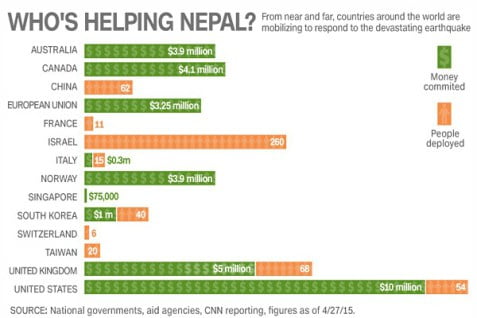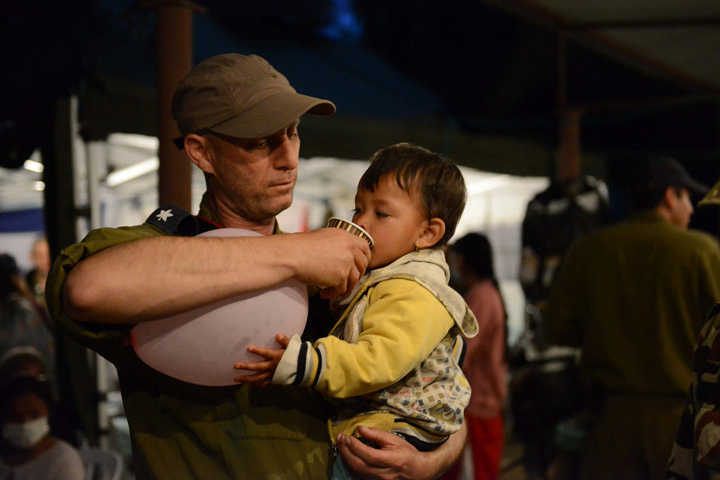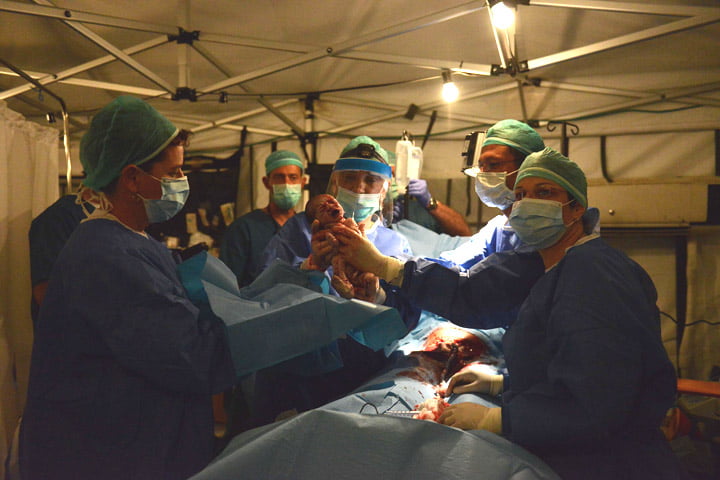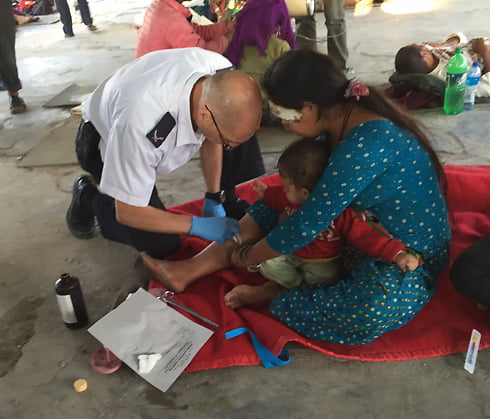Five days after one of history’s most devastating earthquakes hit Nepal, countries near and far are pouring in funds and personnel to address the state of emergency. Leading the pack in terms of medical and rescue personnel on the ground is Israel, with an aid convoy of 260 personnel, including about forty doctors. While this isn’t the first time that Israel has stepped in to following a major international weather event, the Israeli team is using innovative and ingenious technology to rescue more people from the areas of destruction and to provide first-class medical care to those who need it most.
Israelis set up state-of-the-art field hospital
Mere hours after the 7.8 scale earthquake rumbled Nepal, Israeli rescue teams were already prepping their gear for the flight to Kathmandu. The aid convoy organized by Israel is the largest ever sent by the Israeli Defense Forces overseas, and according to a CNN report, it has the most personnel on the ground of any other country. Constructing one of the largest field hospitals in Kathmandu with the ability to treat up to 200 patients a day, the Israeli station is also one of the most technologically advanced in the disaster zone.
 “The team brought the most recent technology possible,” says IDF Medical Corps doctor Lt. Col. Asi Hempel. “The field hospital will be equipped with everything: x-rays, operating rooms that will work 24/7, laboratories and more.”
“The team brought the most recent technology possible,” says IDF Medical Corps doctor Lt. Col. Asi Hempel. “The field hospital will be equipped with everything: x-rays, operating rooms that will work 24/7, laboratories and more.”
The Israeli field hospital has also set up a novel system to provide each patient with their own digital medical file, “Each patient who arrives at the field hospital is greeted by a medical assistant who takes his picture and gives him a unique barcode,” Lt. Col. Hempel explained in a statement. “This barcode is scanned at every station the patient goes through, allowing the doctor to access any and all medical information and treatments the patient receives. This system allows us to ensure that no station in the hospital is overwhelmed with patients. Quality treatment is priority,” he continued.
SEE ALSO: 10 Israeli Companies At The Cutting-Edge Of Life Saving Tech
The Israeli medical teams plan to treat hundreds if not thousands of patients at their state-of-the-art field hospital, but Israeli medical innovations in Nepal don’t stop there. The IDF medical crew brought what is considered a breakthrough medical technology called powered plasma to the hospital, an Israeli invention that allows for infinite supplies of blood that doesn’t need to be refrigerated. The field hospital staff just needs to add water to activate the plasma.
Making good use of Israeli live-saving tech
Aside from the advanced field hospital, Israeli medical and emergency response apps and technologies are going to good use in Nepal. One particular smartphone application called NowForce Life Compass is being used as a major communications platform between the central rescue command in Israel and the field commanders on the ground.
“All of the response teams have a NowForce application on their phones, providing them with full situation awareness in the palm of their hand,” NowForce CEO Assaf Shafran tells NoCamels. “The application allows for coordination between what the command center sees at home in Israel and what the field commanders are doing on the ground. In addition, field commanders are able to update personal safety components all the time and they are able to tag certain locations where they see that additional attention is needed and to identify dangerous areas.”
Sign up for our free weekly newsletter
SubscribeNowForce’s technology is based on satellites, so despite the widespread damage to communications infrastructure, including Internet access, field commanders are able to map-out potential rescue sites – invaluable on-the-ground information that will be used by Israeli units to carry out targeted rescue missions.
SEE ALSO: After Thousands Of Years Of Stitching, Israelis Invent New Wound-Closure Method
Emergency Bandage, colloquially known in the American military as the “Israeli bandage”, is another medical technology being used to stop and control bleeding in serious hemorrhagic wounds. The bandage was invented by Israeli military medic Bernard Bar-Natan in the 1980s and was applied by NATO troops in the peacekeeping operation in Bosnia and Herzegovina, as well as by the US military in Operation Iraqi Freedom. The bandage is now a mainstay for many emergency responders, and was used to save the life of Arizona Congresswoman Gabrielle Giffords following a head-shot wound in 2011.
The Israeli-invented Viber messaging service is also being used to save lives according to the Economic Times, allowing users to make calls from Nepal free of charge in the two days following the earthquake. The service allows those who need to, and have Internet access, to make calls to mobile and land-line numbers.
Other Israeli tech coming to the rescue includes the PocketBVM, or emergency masks and breathing devices that can be used to prevent shortage of breath in the wounded until they receive medical care. Though it wasn’t applied in the Nepal earthquake, in other international disasters Israeli-created platform eVigilio has been used to send out mass alerts to millions of people regarding imminent natural disasters and security threats. Another piece of Israeli life-saving tech that could be used to locate the hundreds, if not thousands, of individuals still trapped under the rubble is the Technion’s “Snake Robot”. The flexible and easily maneuverable robot can reach the locations that are too dangerous or hidden for rescue workers to reach, currently a very serious challenge for rescue workers in crowded areas of Kathmandu.
Though Israel certainly has the most active and innovative rescue team currently on the scene in Nepal (the CNN survey doesn’t include India), the Startup Nation has donated minor to no relief funds, while bigger countries like the United States and the United Kingdom have donated $10 million and $5 million, respectively. However, based on the breadth of Israeli involvement in past aid missions to disaster zones in Japan, Haiti and the Philippines, and with Nepalese and other foreign aid workers referring the wounded to the advanced Israeli field hospital, it seems that the international community may owe Israel a hearty pat on the back.
Photos: MFA
Related posts

Editors’ & Readers’ Choice: 10 Favorite NoCamels Articles

Forward Facing: What Does The Future Hold For Israeli High-Tech?

Impact Innovation: Israeli Startups That Could Shape Our Future






Facebook comments